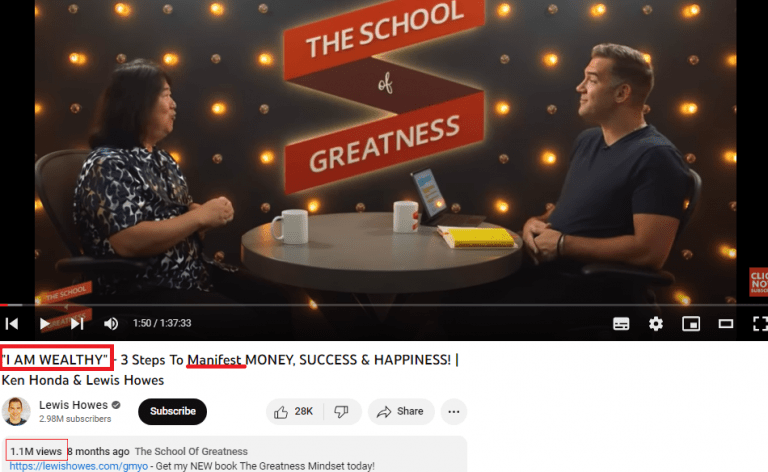Flat Belly Fix: Sales & Persuasion Tactics Exposed
How does a former cop persuade people to buy his secret weight loss tea recipe?
It sounds unlikely. But using highly persuasive marketing techniques, Flat Belly Fix has become one of the top-selling health and fitness programs on Clickbank.
Flat Belly Fix is a weight loss program created by Todd Lamb. The program claims to have a secret tea recipe that burns body fat.
In this post, I will review three key marketing techniques used in the Flat Belly Fix video sales presentation. These techniques are commonly used by some of the best marketers in the health and fitness space.
The weight loss industry is worth $72 billion in the US alone. Businesses know that the market is desperate for results and often use manipulative marketing tactics to take advantage of a vulnerable audience.
In this post you will how the team behind Flat Belly Fix:
- Create a highly engaging and emotional story
- Prime viewers into a buying state, where they are desperate for change
- Take the viewer on an emotional rollercoaster
- Apply proven psychology principles to make the audience like Todd Lamb
What is The 21 Day Flat Belly Fix?
The 21 Day Flat Belly Fix is a weight loss system created by Todd Lamb. Lamb’s system promises to help people get rid of unwanted (belly) fat and see rapid results on the scale.
The program is presented as an easy-to-follow guide to shedding weight in just a few weeks. Its founder, Todd Lamb, claims that the secret to the efficacy of his system is an unusual tea recipe, which helps people “burn a TON of fat without moving a muscle.”
The 21 Day Flat Belly Fix also includes a 7-minute ab workout and a smoothie recipe book. But Lamb emphasizes that it’s the tea recipe that is the key to success.
Who is Todd Lamb and Who is His Audience
On his website, Todd Lamb says he is a “17-year veteran police officer and a recently retired SWAT Team Leader with over 350 completed missions.”
As a “tactical fitness expert,” he offers advice and multiple courses on fitness, combat, nutrition, and weight loss. His online store includes courses like Specforce Abs, Combat Fighter, Combat Shooter, First Strike, Eat Sleep Burn, and others.

His brand Alpha Nation targets young to middle-aged men, wanting to build strength and power.
But the Flat Belly Fix program targets a very different audience. This audience is likely to consist of middle-aged men and women who want to lose weight.
So how does this tough cop, with no scientific background, convince people that he has discovered a previously unknown solution for weight loss?
The Power of Storytelling
Storytelling is a powerful tool that marketers use to capture people’s attention.
In my blog post on Diabetes Freedom, I explain how storytelling can have a strong impact on the audience. That post explains why our brains react to stories better than they do to facts and figures.
Todd Lamb uses storytelling in the Flat Belly Fix sales video to engage the viewer and grab their attention.
There are a few key elements that make Todd’s use of storytelling particularly persuasive…
Use of Emotionally Dense Language
The Flat Belly Fix video begins with a distressing scream.
This scream immediately captures the viewer’s attention, but it does more than that.
Screams activate the amygdala – the fear center in the brain – and trigger the release of fight-or-flight hormones – cortisol and adrenaline.

As a result, the viewer is immediately put in a highly alert state. This is a very calculated move that benefits the seller.
Most internet users have very scattered attention. And marketers are fighting a battle to capture that attention.
This dramatic start to the video is a way of saying, “Hey, listen! Something important is gonna happen here. So, stay alert!”
In addition, a highly dramatic and emotional scene like this puts the viewer into a state known as fight or flight mode. This specific state has been linked to impaired logical reasoning, which makes the audience more susceptible to persuasion and control.
Next, consider the language Todd uses throughout the presentation. Regardless of whether you are listening to the presentation or reading the transcript, you are exposed to words that are packed with emotions.
Pay attention to how many adjectives he uses to describe each feeling, each state of mind. This immediately makes the story more dramatic and causes the reader to feel the story.

This emotionally charged language makes the story far more compelling to the viewer. The best writers in the world use language that evokes strong emotions to draw in their audience.
The PAS Formula in Storytelling
The PAS Formula is a well-known tool for marketers and copywriters. It’s a simple but powerful tool that you can use to structure your message to the audience.
PAS stands for Problem.Agitate.Solve. This is how it’s applied…
Problem: Present a problem you know your target audience is struggling with.
Agitate: Intensify the viewer’s negative emotions regarding their issue. Make your audience see and feel that they need a solution to their problem.
Solve: Present the solution.
Todd’s story follows the same structure.
He starts by identifying the problem – being overweight, having excess belly fat, and not being able to lose the extra pounds through exercise and dieting.
Next, he taps into people’s negative emotions regarding their body image and presents the issue – being overweight – as unbearable and devastating. To achieve that, Lamb uses a variety of extreme, emotionally charged words to describe his wife’s experience – hopelessness, enemy, self-loathing, hate, useless, disgusting, never, always, etc.
Once the negative emotions of the viewer reach their peak, Lamb presents the solution – his secret tea recipe.
The reason why the PAS formula works so well is that it resonates with the viewer’s thought process: they can relate to the problem; they become agitated by its negative impact on their lives; they crave the solution.
In one of my previous posts, you can read how Anik Singal uses the PAS formula to generate millions of dollars from his online products.
Identifying With The Audience
In his book Never Split The Difference, former FBI hostage negotiator Chris Voss explains that one of the keys to negotiation is making the other side feel understood.
Nobody will make a deal with you if they feel like you don’t understand them.
Todd Lamb presents a story that makes the audience feel like he understands them. He understands their struggles, their pain and their fears.
Many people who struggle with weight loss do feel hopeless, powerless, and frustrated. Some might even hate their bodies and see them as “the enemy.” They can identify with Tara – Todd’s wife.
By showing the audience that he understands what they’re going through, Todd puts himself in a much stronger position to influence them.
A Happy Ending
Another reason the story is so effective is that it offers a happy ending.
Firstly, the audience is able to identify with Tara; they have seen the pain and struggles she experienced.
Then they see the positive transformation that occurred. The audience learns that Tara was able to overcome those struggles and change her body.

This gives the audience hope that they too can overcome the same challenge and experience a positive transformation like Tara did.
Todd uses before and after photos of Tara to make the transformation more visible and provide evidence to the viewer.
Good marketing and sales letters will sell a transformation. Showing people how they can become a better version of themselves is extremely powerful.

Future Pacing – The Future With & Without Flat Belly Fix
Future pacing is a persuasion technique used in NLP. It takes the audience on an imaginary journey to the future – a future influenced, or predetermined, by the impact of the product.
Future pacing is an extremely effective tool because it gives the audience a taste of what they desperately crave. They can feel what it would be like to achieve their goals and reap all the desired benefits.
Through his presentation, Todd gets the viewer to imagine just how good life will be if they use the Flat Belly Fix program.
People have a natural tendency to believe that if they can resolve one major problem in their life, it will fix all other problems.
For example, someone might blame their weight for not getting the job they want. Or for not having the social life they want. But if they can only solve the weight problem, then everything will be different.
This is another reason why the future pacing technique is so seductive. The audience not only imagines how life will be when they look in the mirror and see a slimmer, more attractive version of themself. But they also imagine how all other aspects of their life will be better as well.
In many cases, this bright future is contrasted to, and thus highlights, the negative aspects of the present. This makes viewers even more eager to pursue the path of change.
This is a tactic commonly used in weight loss marketing campaigns.
In his presentation, Todd gets the viewer to imagine a future with and without the miracle tea he offers.

Todd has the viewer imagine just how bad their life will be if they choose not to do anything.
Getting people to change their behavior or buy a product is difficult. As I’ve discussed in previous articles, humans naturally gravitate towards the easy option.
And generally, the easy option is to do nothing at all. Because changing your behavior or making a purchase requires energy.
But people will act when the pain of inaction eclipses the pain of taking action. That’s why Todd uses future pacing to increase the pain associated with inaction.

You will often see the future pacing technique used on websites and commercials.
A good example of this can be found on Zipporah Monique’s website, where she promotes her confidence challenge course.

In the example above, Zipporah uses future pacing to get the reader to imagine their future after completing her course. Here she is overcoming human inertia by increasing the pleasure associated with taking action.
How Todd Lamb Uses The Liking Principle
According to author of Influence, Dr. Robert Cialdini, we are more likely to buy from and follow people we like. For example, someone we are already close to (a friend or family member), or someone we find physically attractive.
Former FBI hostage negotiator Chris Voss says we’re 6 times more likely to make a deal with someone we like.
So how does Todd use the liking principle to his advantage?
We Like People Who Are Similar to Us
We as human beings, like to think of ourselves in a positive light. Consequently, we perceive people who are similar to us as likable and trustworthy.
In the Flat Belly Fix sales video, Todd presents himself as being similar to the target audience. As we can see, he adapts his style to match the specific audience he addresses through his sales campaign.

He also demonstrates empathy towards his audience by showing them that he understands their struggles. He has been ‘in their shoes’ – even though he experienced the pain and devastation indirectly (through his wife’s struggle).
Showing empathy is a powerful and effective way to make your audience see you in a more positive light. And that’s simply because people like to feel understood and accepted.
We Like Heroes
Lamb presents himself as a dedicated husband, who loves his wife “no matter what she looks like.”
He shares the story of how he stuck by his wife’s side, even through the tough times.

The emphasis on Lamb’s commitment to his marriage makes the viewer like, trust, and respect him.
Similarly, internet entrepreneur Anthony Morrison shares a compelling story about how he decided to start his business because he wanted to save his family from financial disaster.
He cares so much about his parents that he is ready to try anything for them and work as hard as humanly possible to help them.

By sharing stories like this that demonstrate strong values, Morrison, Lamb and others are able to generate positive feelings towards themselves. They know this will improve the chances that someone will buy from them.
Liking Through Association
Brands and people can make themselves more likeable by associating themselves with things that the audience already views favorably.
This is partly why celebrity endorsements are effective. If you like a celebrity, your positive feelings towards them are likely to be transferred to any products they endorse.
A good example of this is Brendon Burchard, who showcases a picture of himself and Oprah on his masterclass sales page.

Many people already like Oprah and associate her with positive qualities. When they see this picture, Brandon’s viewers are likely to automatically transfer their positive associations with Oprah to Brandon.
Todd uses his background as a police officer to leverage liking through association.
He emphasizes that his mission is to protect and help others.

He knows his target audience is likely to hold positive associations with police officers.
Brands are often trying to present themselves as more likable by using positive associations.
Notice, for example, how H&M’s Conscious campaign aims to appeal to customers by linking the H&M brand to environmental sustainability, transparency, innovation, and inclusiveness – concepts that their target market generally view as positive.

Summary
The 21 Day Flat Belly Fix sales presentation is a great example of how marketers can use storytelling, future pacing, and the liking principle to convert viewers into paying customers.
These three persuasion strategies are particularly prominent in Todd Lamb’s campaign and extremely powerful when used to sell personal transformation products.
Todd also uses techniques like price anchoring, loss aversion, the Foot in the Door technique to make his product even more compelling.
Even if your business doesn’t sell weight-loss products or courses, you can still apply the techniques discussed in this post.
In my other blog posts, I describe these (and other) persuasion techniques in detail and with real examples.
If you are curious to discover more marketing principles and understand the psychology behind them, check out some of my other posts below.
Marketing Psychology Principles Explained With Real Examples







